The more crowded campgrounds get, the more I want to get off the beaten path. Another world awaits us. A world of quiet contemplation and dirt. A place that holds the promise of new experiences and thrilling escapades. If you’d like to take a travel trailer to this off-road Mecca, you’re probably wondering, “What makes an off-road trailer?”
A hefty suspension, high ground clearance, strong construction, exterior protection, beefy off-road tires, and a strong, articulating hitch are the elements that make a trailer off-road worthy.
With a sturdy travel trailer at their side and a spirit of adventure in their hearts, the off-road traveler sets out to explore the world and all its wonders. Read on to find out the nitty-gritty of an off-road camper trailer.
Off-road Travel Trailers have a Hefty Suspension
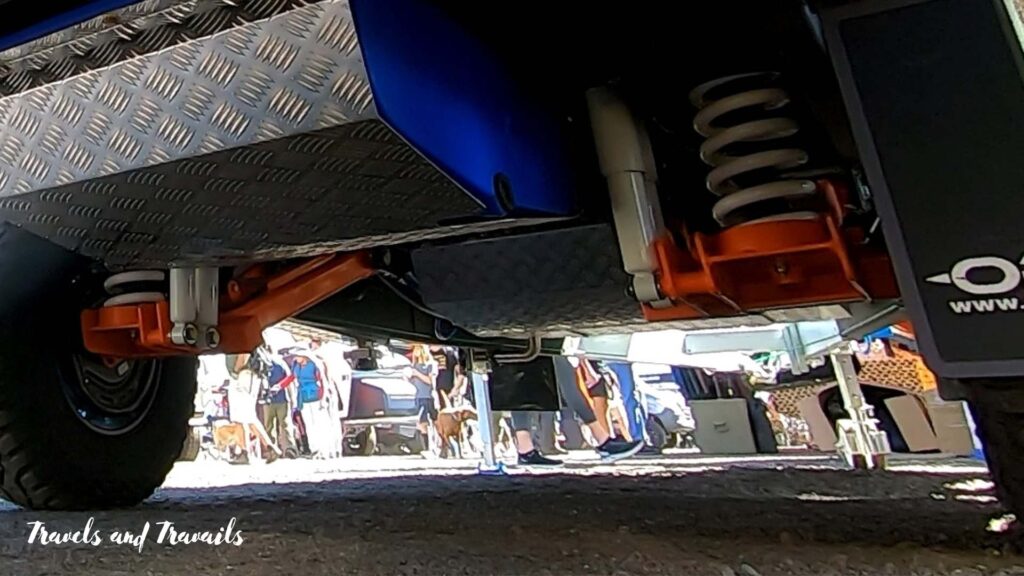
A travel trailer with off-road capabilities should have a suspension system that can handle rough terrain. This typically means a heavy-duty, independent suspension system with shock absorbers.
Off-road travel trailer suspensions are designed to handle rugged terrain. They typically feature heavy-duty, independent suspension systems with shock absorbers. These suspensions provide better stability and control on uneven roads. Off-road suspensions also have more ground clearance to prevent damage from rocks and other obstacles.
The suspension’s shock absorbers help reduce the impact of bumps and vibrations, improving the ride quality for passengers and minimizing damage to the trailer. Independent suspension allows each wheel to move independently, improving traction and handling on uneven surfaces. Off-road suspensions also typically have larger tires for better traction and improved ground clearance.
Overall, off-road travel trailer suspensions are an important consideration for anyone looking to explore rough or remote terrain. A strong suspension system can help ensure a smoother, safer ride and protect the trailer from damage on the road less traveled.
There are four types of independent suspension:
- Double wishbone suspension
- Multi-link suspension
- MacPherson strut
- Transverse leaf-spring
Off-road Travel Trailers have Plenty of Ground Clearance

Off-road travel trailer ground clearance is the distance between the bottom of the trailer and the ground. Higher ground clearance is important for off-road travel to prevent damage from rocks and other obstacles. It allows the trailer to clear larger obstacles, like rocks and logs, without getting stuck or damaged.
The ground clearance can be increased by using larger tires and installing a lift kit. Larger tires can provide better traction on rough terrain, while a lift kit raises the trailer’s body, increasing ground clearance. Higher ground clearance also allows for a better departure angle, which is important when climbing over obstacles or descending steep hills.
Off-road travel trailer ground clearance is an essential consideration for anyone planning to take their trailer off-road. The higher ground clearance can help prevent damage to the trailer and make it easier to navigate rough or uneven terrain, allowing travelers to reach more remote locations and experience the beauty of the great outdoors.
Ground clearance is typically measured at the lowest point of the trailer, which is often the axle. It’s important to consider the clearance of other parts of the trailer as well, such as the corners and the hitch.
In addition to larger tires and lift kits, ground clearance can also be increased by adjusting the suspension system. A suspension with greater travel can help keep the trailer level on uneven terrain, while adjustable shocks can be used to fine-tune the height and handling of the trailer.
It’s important to note that increasing ground clearance can also affect the trailer’s stability and towing dynamics. Higher ground clearance can lead to a higher center of gravity, which can increase the risk of rollover. It’s important to make sure that any modifications made to the trailer are done safely and with consideration for the overall towing setup.
Off-road Travel Trailers have Strong Construction
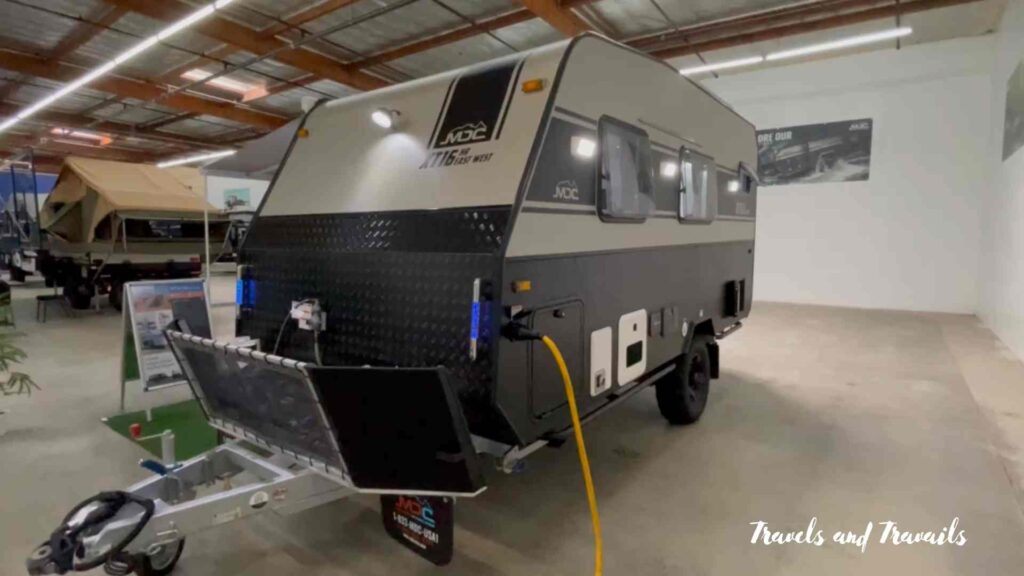
Off-road travel trailers need to be constructed with durable materials to handle rough terrain. This typically means a sturdy frame, reinforced corners, and thick walls. Strong construction is important to prevent damage to the trailer and keep occupants safe on bumpy roads. Most off-road travel trailers are built with steel or aluminum frames, which provide strength and durability without adding too much weight.
The exterior of an off-road travel trailer is typically made of fiberglass or aluminum. These materials are lightweight and resistant to damage from rocks and debris on the road. Fiberglass is more durable, while aluminum is more lightweight and easier to repair.
The interior of an off-road travel trailer is often designed with rugged, easy-to-clean materials like vinyl flooring and synthetic upholstery. Cabinets and fixtures are securely mounted to prevent damage during rough travel.
Other features of an off-road travel trailer’s strong construction may include reinforced corners and edges, sealed seams to prevent water infiltration, and additional insulation to improve temperature control and noise reduction.
Off-road Travel Trailers Have Protection from Rocks and Debris
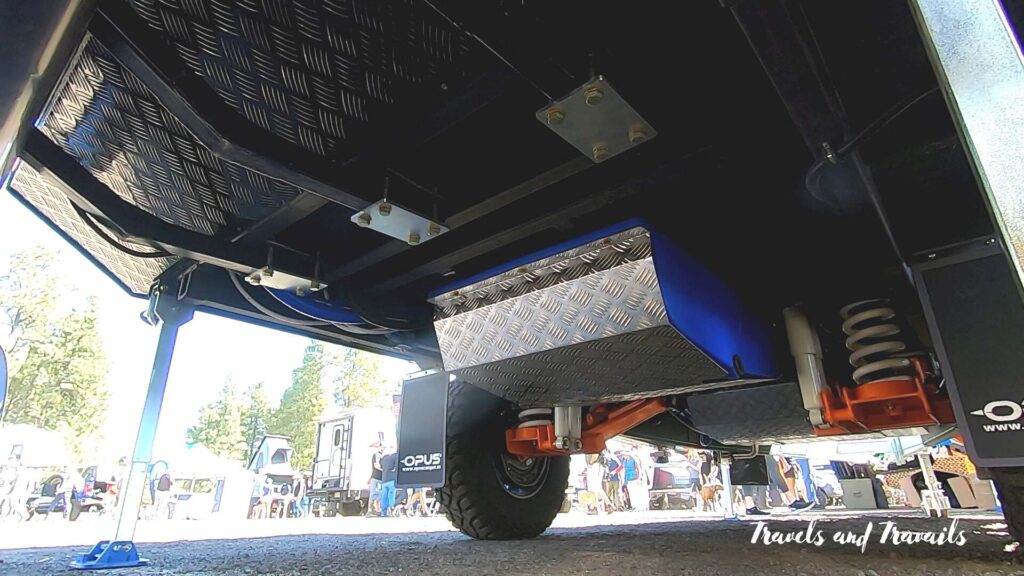
A travel trailer designed for off-road use should have additional protection to prevent damage from rocks, branches, and other hazards. This can include reinforced underbelly skid plates, rock guards, and heavy-duty fenders.
One important feature for protection is a rock guard or stone shield. These shields are typically installed on the front of the trailer and are designed to deflect rocks and other debris away from the trailer.
Another feature for protection is fender flares. These are extensions of the wheel well that provide additional coverage and help prevent rocks and debris from hitting the trailer. Fender flares also help to reduce the amount of mud and dirt that gets kicked up onto the trailer.
Skid plates are another important feature for protecting the underbelly of the trailer. These are typically made of metal and are mounted to the frame of the trailer. Skid plates help to prevent damage to the underside of the trailer from rocks and other obstacles on the road.
Rock sliders are another important feature of off-road travel trailers. These are typically metal bars or plates that are mounted to the sides of the trailer, providing an additional layer of protection against rocks and other obstacles on the road.
Rock sliders help to prevent damage to the lower portion of the trailer’s body and frame. They also provide a sturdy step for entering and exiting the trailer, which can be especially helpful for taller trailers or when the ground is uneven.
In addition to protecting the trailer, rock sliders can also help prevent damage to the tow vehicle. If the trailer were to tip or roll, rock sliders can help prevent the trailer from damaging the side of the tow vehicle.
Off-road Travel Trailers Have Off-road Tires
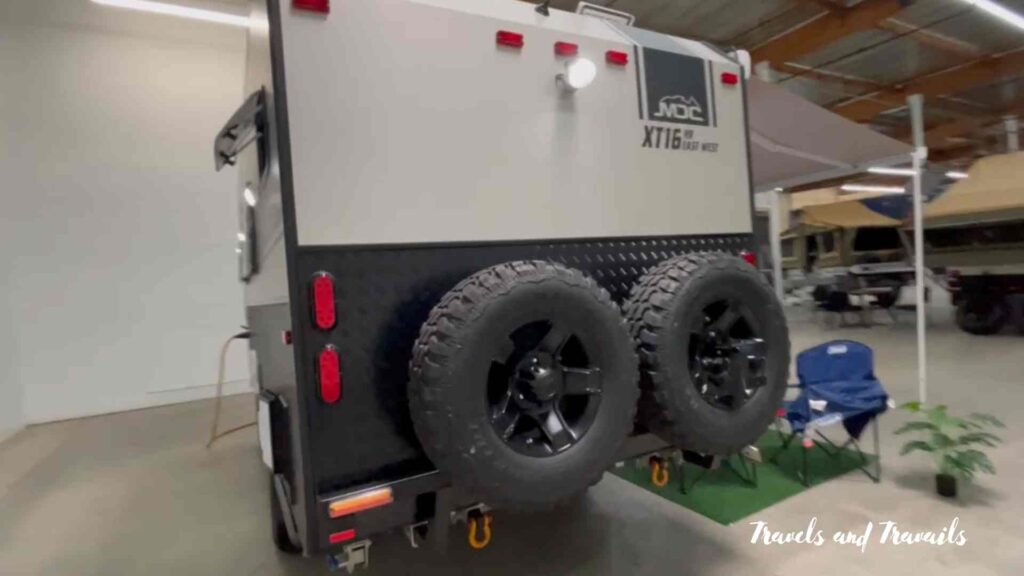
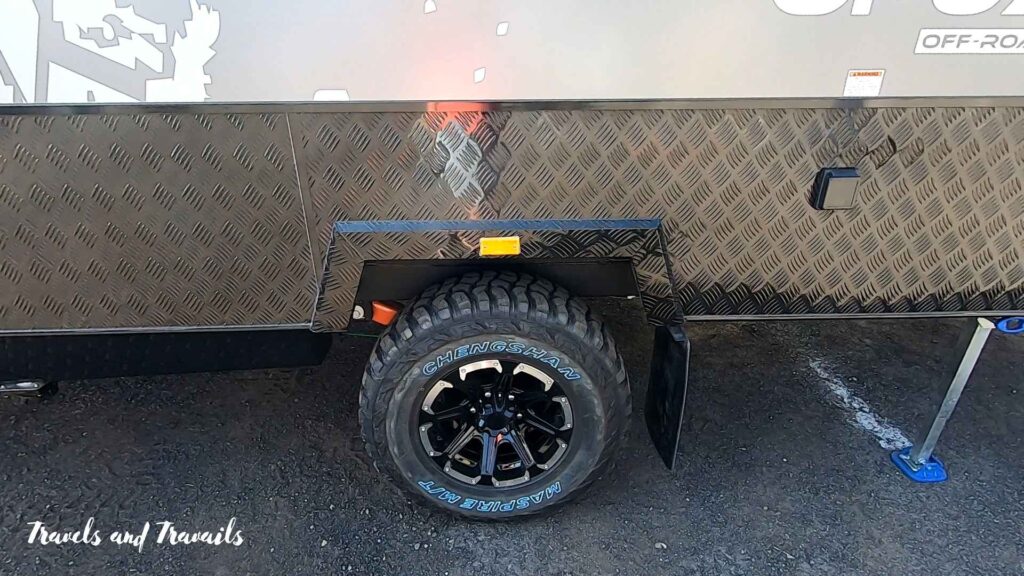
The tires on an off-road travel trailer should be designed for rough terrain, with a durable tread pattern that can handle mud, rocks, and sand.
Off-road tires are an important feature for off-road travel trailers. These tires are designed with deeper treads and thicker sidewalls to provide better traction and protection against punctures from rocks and other debris.
Off-road tires are typically made of a harder rubber compound, which provides better durability on rough terrain. The deeper treads help to improve traction in mud, sand, and other challenging terrains.
Another important feature of off-road tires is their ability to deflate and inflate easily. This can be especially helpful when traveling over sand or other soft surfaces, as deflating the tires can increase their surface area and provide better traction.
It’s important to note that off-road tires can have a negative impact on fuel economy, as they often have higher rolling resistance than standard highway tires. However, the improved performance and durability they provide on rough terrain can be well worth the tradeoff.
Off-road tires come in a wide range of sizes, with varying widths, aspect ratios, and wheel diameters to suit different vehicles and terrains. Here are some common sizes of off-road tires:
- 31×10.50R15: This is a popular size for smaller off-road vehicles and light-duty trucks. The tire has a width of 10.50 inches, a height of 31 inches, and fits a 15-inch wheel.
- 33×12.50R15: This tire size is a step up from the 31×10.50R15, with a wider width of 12.50 inches and a height of 33 inches.
- 35×12.50R17: This is a common size for larger off-road vehicles and heavy-duty trucks. The tire has a width of 12.50 inches, a height of 35 inches, and fits a 17-inch wheel.
- 37×12.50R20: This is a large and wide tire size that’s suitable for extreme off-roading. The tire has a width of 12.50 inches, a height of 37 inches, and fits a 20-inch wheel.
Off-road Travel Trailers Have Special Hitch and Towing Systems
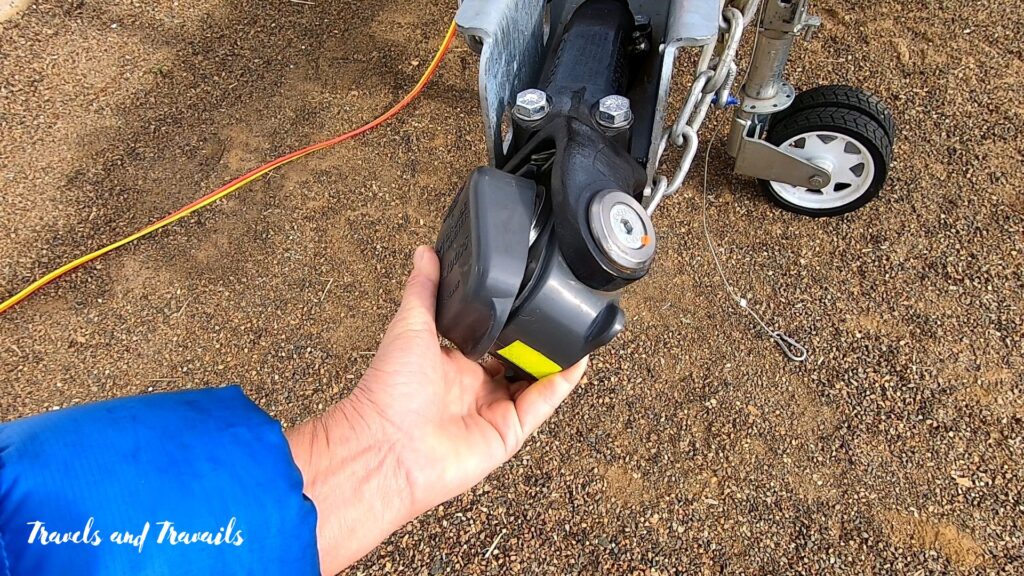
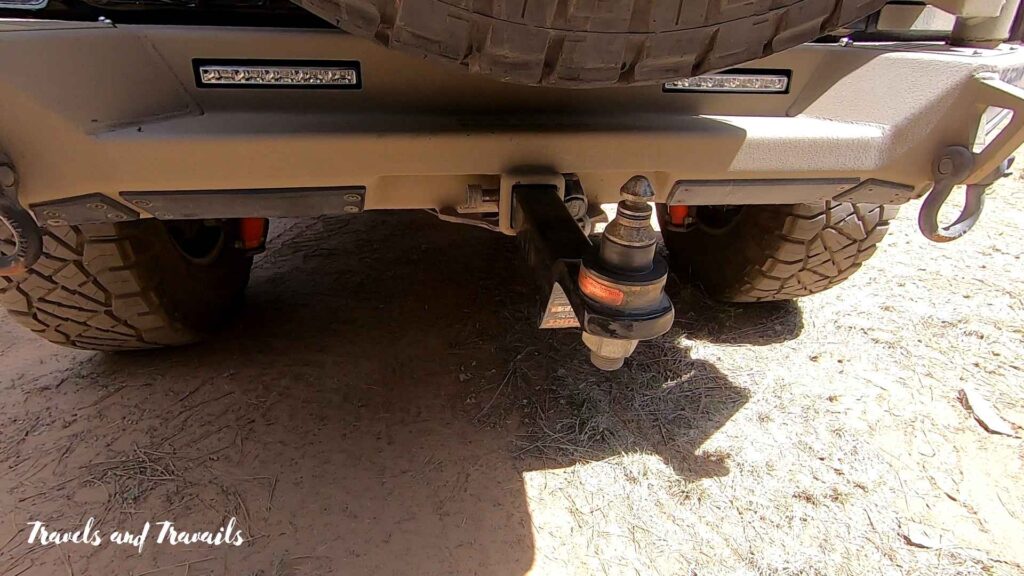
An off-road travel trailer should have a strong hitch and towing system to ensure that it can be securely attached to the towing vehicle.
Off-road camper trailers require a specialized hitch and towing system that can withstand the demands of long-distance travel over rough terrain. These systems typically feature heavy-duty components designed for off-road use.
One important feature of off-road camper trailer hitches is their ability to provide greater clearance and flexibility. Many hitches are designed to be adjustable, allowing for changes in ride height and articulation as the trailer navigates uneven terrain.
An articulating hitch is designed to provide greater flexibility and maneuverability when towing an off-road travel trailer. This type of hitch allows the trailer to pivot and articulate independently from the tow vehicle, which can help to reduce stress on both the trailer and the towing vehicle. Some advantages of an articulating hitch include:
Improved off-road handling: Articulating hitches can help to improve handling and stability on rough terrain, as they allow the trailer to follow the contours of the ground more closely. This can help to reduce the risk of the trailer tipping or becoming unstable in challenging off-road conditions.
Reduced stress on the towing vehicle: Articulating hitches can help to reduce the stress on the towing vehicle’s suspension and chassis, as they allow the trailer to pivot and articulate independently. This can help to improve the towing vehicle’s handling and stability, which can be especially important on long-distance off-road trips.
Greater flexibility: Articulating hitches provide greater flexibility and maneuverability when towing an off-road travel trailer, as they allow the trailer to pivot and turn more easily. This can make it easier to navigate through tight spaces or obstacles on challenging off-road trails.
Improved comfort: Articulating hitches can help to improve the comfort and stability of the travel trailer’s interior, as they help to reduce the amount of movement and sway inside the trailer. This can make for a more comfortable and enjoyable travel experience for passengers inside the trailer.
Off-road Travel Trailers Have Maneuverability
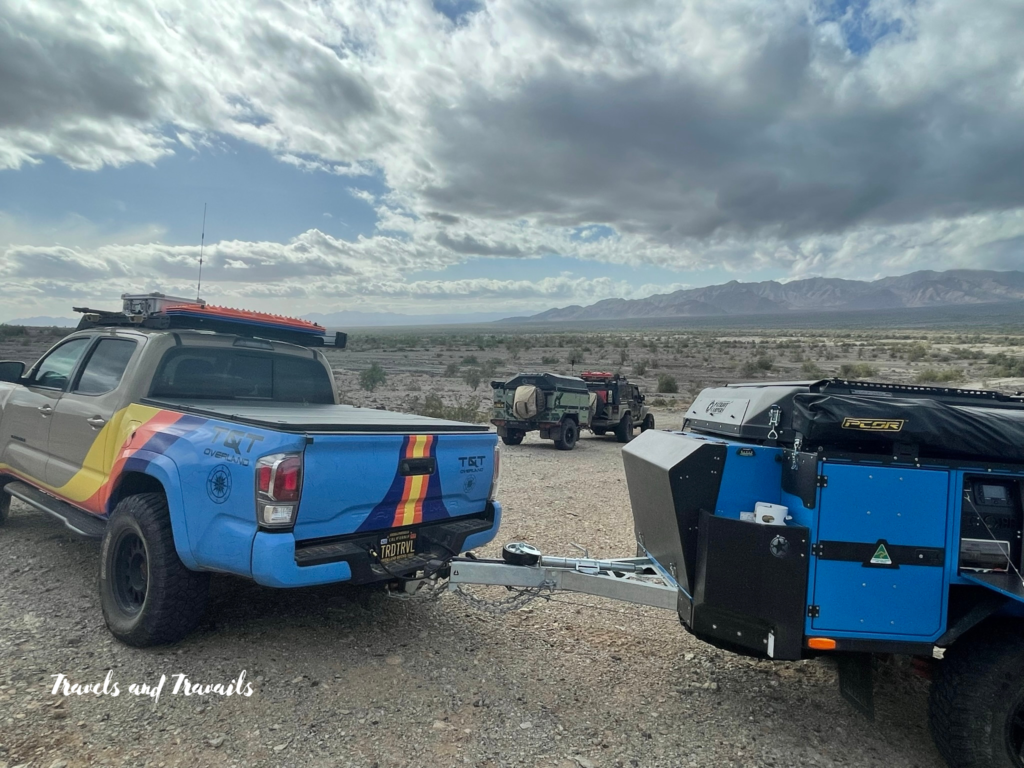
An off-road travel trailer should be designed for easy maneuverability, with features such as compact size, a tight turning radius, and a low profile.
Off-road travel trailers need to be highly maneuverable to navigate through rugged terrain and tight spaces. Maneuverability is affected by factors such as the trailer’s length, width, and turning radius, as well as its weight and center of gravity.
One way to improve maneuverability is to choose a travel trailer with a shorter length and narrower width. This makes it easier to navigate through tight spaces, such as narrow mountain passes or winding forest trails.
Another factor to consider is the trailer’s turning radius. Trailers with a tighter turning radius can make it easier to make sharp turns or navigate around obstacles, which can be especially helpful on rough terrain.
The weight and center of gravity of the trailer can also impact its maneuverability. Trailers with a lower center of gravity and a balanced weight distribution are generally more stable and easier to maneuver. This is because they are less likely to sway or tip over on uneven terrain.
Off-road Travel Trailers Have Ventilation Systems
Off-road travel trailers are often equipped with positive-pressure ventilation systems to help keep dust and other debris out of the interior of the trailer. These systems work by creating a slight positive pressure inside the trailer, which helps to prevent dust and other particles from entering through any gaps or openings.
Positive pressure ventilation systems typically include a fan or blower that draws in fresh air from outside the trailer and circulates it throughout the interior. This creates a positive pressure inside the trailer, which forces any dust or debris to be pushed out through any gaps or openings in the trailer’s exterior.
One advantage of positive pressure ventilation systems is that they can help to improve the air quality inside the trailer. By preventing dust and other particles from entering, these systems can help to reduce the risk of respiratory problems and allergies caused by airborne contaminants.
Another benefit of positive pressure ventilation systems is that they can help to keep the interior of the trailer clean and free from dust and debris. This can be especially important when traveling on dusty off-road trails, where dust can easily enter the trailer and accumulate over time.
Conclusion
An off-road travel trailer is a rugged and durable vehicle designed for adventure seekers who want to explore remote and challenging terrain. The features that make a travel trailer off-road worthy are essential for a safe and enjoyable experience. With a heavy-duty suspension system, high ground clearance, strong construction, added protection, off-road tires, and a secure hitch and towing system, these trailers can withstand the toughest conditions and provide a comfortable and reliable home away from home. Whether you’re exploring the mountains, the desert, or the backcountry, an off-road travel trailer can take you there and back, making your outdoor adventures more memorable and exciting.
